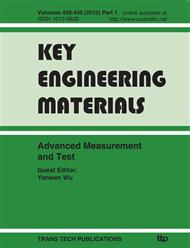[1]
T. Zhu, F. Gao and G. Liu: Pre-estimation of fatigue life time of welding spots of BIWs (Chinese). Automobile Technology. Vol. 2 (2006), pp.37-39.
Google Scholar
[2]
A. Jia, X. Jiang, G. Hui, H. Yao and X. Xi: Artificial neural network prediction of the microstructure of 60Si2MnA rod based on its controlled rolling and cooling process parameters. Mater. Sci. Eng. Vol. A344 (2003), pp.318-322.
DOI: 10.1016/s0921-5093(02)00444-6
Google Scholar
[3]
N.S. Reddy, A.K. Prasada Rao, M. Chakraborty and B.S. Murty: Prediction of grain size of Al-7Si Alloy by neural networks. Mater. Sci. Eng. Vol. A391 (2005), pp.131-140.
DOI: 10.1016/j.msea.2004.08.042
Google Scholar
[4]
Ó. Martín, M. López, P.D. Tiedra and M.S. Juan: Prediction of magnetic interference from resistance spot welding processes on implantable cardioverter-defibrillators. Journal of Materials processing technology. Vol. 206 (2008), pp.256-262.
DOI: 10.1016/j.jmatprotec.2007.12.021
Google Scholar
[5]
C. Liang and X. Liu: Strength prediction of sheet to tube single sided resistance spot welding, Materials and Design Vol. 30 (2009), pp.4328-4334.
DOI: 10.1016/j.matdes.2009.04.015
Google Scholar
[6]
X. Wang, C. Xu, J. Zhang, S. Li and Y. Niu: Fatigue life prediction of friction stir welding joints of aluminum alloy 707027651 based on BP algorithm of neural network (Chinese), Journal of Lanzhou University of Technology. Vol. 34 (2008).
Google Scholar
[7]
D. Yan, D. Zhou, C. Huang and Z. Wu: Modeling and predicting of LCCC solder Joint 3-D shape by minimum potential energy theory (Chinese), Journal of Guilin University of Technology. Vol. 26 (2006), pp.107-110.
Google Scholar
[8]
S. Pal, S. K. Pal and A. K. Samantaray: Artificial neural network modeling of weld joint strength prediction of a pulsed metal inert gas welding process using arc signals, Journal of Materials processing technology. Vol. 202 (2008), pp.464-474.
DOI: 10.1016/j.jmatprotec.2007.09.039
Google Scholar
[9]
L. Di, T. Srikanthan, R.S. Chandel and I. Katsunori: Neural-network based self-organized fuzzy logic control for arc welding. Engineering Application of Artificial Intelligence. Vol. 14 (2001), pp.115-124.
DOI: 10.1016/s0952-1976(00)00057-9
Google Scholar
[10]
Ó. Martín, M. López and F. Martín: Artificial neural networks for quality control by ultrasonic testing in resistance spot welding, Journal of Materials processing technology. Vol. 183 (2007), pp.226-233.
DOI: 10.1016/j.jmatprotec.2006.10.011
Google Scholar
[11]
F. Chen: Genetic algorithms and artificial neural network-Training artificial neural network by EGA-GDR. Journal of Chemical Industry and Engineering. Vol. 47 (1996), pp.280-286.
Google Scholar
[12]
Y. Zhong and B. Wang: BP network sequence prediction model based on genetic algorithm (Chinese). Systems Engineering and Electronics. Vol. 24 (2002), pp.9-11.
Google Scholar
[13]
X. Xue, W. Zhang and H. Liu: Estimation of bearing capacity of bolts on genetic neural network (Chinese), Journal of Engineering Geology. Vol. 14 (2006), pp.249-252.
Google Scholar
[14]
L. Wei, W. Xu, Z. Jiang S. Liu and J. Chen: Application of genetic neural network method to forecasting horizontal deformation of support structure at foundation pit (Chinese). Journal of Engineering Geology. Vol. 11 (2003), pp.297-301.
Google Scholar
[15]
G.F. Miller, P.M. Todd and S.U. Hedge: Designing neural networks using genetic algorithms. In: Proceedings of Third International Conference on Genetic Algorithms, (1989), pp.379-384.
Google Scholar
[16]
J.H. Holland: Adaptation in �atural and Artificial Systems. Ann Arbor, MI: University of Michigan Press, (1975).
Google Scholar
[17]
D.E. Goldberg: Genetic Algorithm in Search, Optimization, and Machine Learning. New York: Addison - Wesley, (1989).
Google Scholar
[18]
B. Arafehl, A.C. Singhh and M. Putatundask: A neural fuzzy logic approach to material processing. IEEE Transactions on Systems, Man, and Cybernetics Part C: Applications and Reviews. Vol. 29 (1999), pp.362-370.
DOI: 10.1109/5326.777072
Google Scholar
[19]
L.K. Charles, Y. lgor and N. Keith: Solving inverse initial-value boundary-value problems via genetic algorithm. Engineering Application of Artificial Intelligence. Vol. 13 (2000), pp.625-633.
DOI: 10.1016/s0952-1976(00)00025-7
Google Scholar
[20]
X. Zhao, L. Zhang and J. Fan: Prediction of wear trend using combined BP neural network based on genetic algorithm (Chinese), Lubrication Engineering. Vol. 9 (2005), pp.40-42.
Google Scholar


